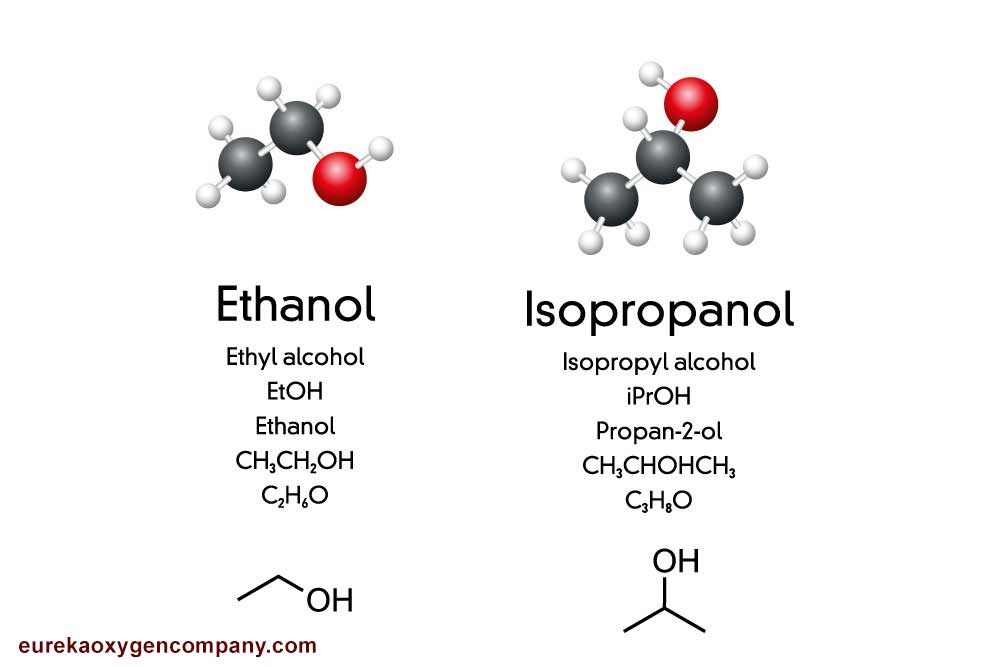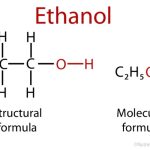“Alcohol” is a word that, like a lot of English terms, has a more specific meaning in science than it does in everyday usage. “Ethanol,” meanwhile, describes a specific chemical substance; while ethanol is a type of alcohol, it also has multiple applications (one industrial, one food-and-beverage-related) that share little overlap.
What’s ethanol? Also called ethyl alcohol, it is the one of simplest alcohols and is certainly the most celebrated, for better or for worse, in Western culture. This humble two-carbon molecule is the center of ample historical controversy, and its use as a mood-altering substance has had significant effects on human societies throughout the history of civilization.
What Is an Alcohol?
Many compounds in chemistry are hydrocarbons, consisting only of carbon and hydrogen atoms. The introduction of oxygen atoms into hydrocarbons opens to the door to a variety of new categories of chemicals with a range of properties.
Alcohols are hydrocarbons in which an -OH group, or hydroxyl group, has been substituted for hydrogen atom. The simplest example is the hydrocarbon methane, which has the formula CH4. Carbon atoms can form four bonds with other atoms and hydrogen only one, so methane is a stable compound. Oxygen, on the other hand, forms a total of two bonds. So a hydroxyl group, which has an oxygen bound to a hydrogen, has one “spot” available for bonding. This means that if conditions are suitable, methane can be converted to methyl alcohol, or methanol. The formula for this molecule is CH3(OH).
While methanol has one carbon atom, ethanol, the next largest and derived from the pure hydrocarbon ethane, has two. The chemical formula for ethane is CH3CH3 (also written C2H6); each carbon atom is bound to three hydrogens and to the other carbon atoms. The formula for ethanol is therefore CH3CH2(OH).
Ethanol is also called ethyl alcohol. This naming convention, as you may have suspected, applies to all alcohols; the “-anol” suffix may be exchanged with the more cumbersome “-yl alcohol.” Knowing that propane is the name of a three-carbon hydrocarbon, can you work out its chemical formula, that of its associated alcohol and the two different names for that alcohol?
Other Alcohols
Because methanol and ethanol are one- and two-carbon alcohols respectively, no ambiguity exists in terms of their formula. That is, given a one-carbon or two-carbon hydrocarbon with a single hydroxyl group in place of a single hydrogen atom, there is only one possible configuration. In the case of ethanol, the carbon to which the -OH is attached is irrelevant because ethane itself is a symmetrical molecule; there is no geometric distinction between the first carbon and the second.
At the level of three-carbon compounds, however, things become more complicated. Propane has the formula CH3CH2CH3 (also written as C3H8). If a hydroxyl group is attached to one of the terminal (end) carbons, the result is ordinary propyl alcohol, or propanol. But what if the hydroxyl group is instead affixed to the middle carbon?
In fact, an important compound called propan-2-ol has just such an arrangement. (You may see this written as 2-propanol in older references; adding the “2” as an infix is a convention that began in 2013 when the International Union of Pure and Applied Chemistry, or IUPAC, developed new nomenclature rules.) The “2” refers to the fact that the hydroxyl group is attached to the second of the three carbons of propane, and is hence in the middle. This substance has three carbons, eight hydrogens and an oxygen, just like regular propanol. As such it is an isomer of propanol, and goes by the name isopropyl alcohol. Most so-called “rubbing alcohol” for antiseptic use contains isopropyl alcohol.
Also, what if more than one hydroxyl group is present? Is the compound in question still in alcohol? In fact, this too occurs. When a second -OH is added to ethanol at the other carbon, this created a molecule called 1,2-ethanediol. The “diol” reveals that the substance is a double alcohol with two hydroxyls, and the “1,2-” prefix indicates that they are attached to different carbons. This alcohol is more commonly called ethylene glycol and is the main component of antifreeze. It is highly toxic (as is methanol).
Another common so-called polyhydroxyl alcohol goes by the common name glycerol or glycerine. This is simply propane with a hydroxyl group substituted for a hydrogen atom at each of the three carbon atoms, all on the same side of the propane molecule. The formal name for this substance is thus 1,2,3-propanetriol, and it both serves as the “backbone” for dietary fat molecules and can be used directly by cells for fuel.
Ethanol Synthesis
Ethanol is made from corn and other plant matter. Ethanol more generally is made from the molecule glucose, which exists in starches of all kinds and is the main form of energy used by all living cells. One molecule of glucose is converted to ethanol and carbon dioxide under the influence of yeast, which acts as an enzyme to encourage the reaction along:
C6H12O6 → 2C2H5OH + 2CO2
This reaction is known as fermentation as it is a form of anaerobic (without oxygen) respiration. Another type of fermentation reaction is lactic acid fermentation, which is what your body undergoes when you are exercising too intensely to allow oxygen consumption and processing to keep pace with your energy needs. Both kinds of fermentation are alternatives to aerobic respiration, in which glucose is processed in cell mitochondria through the Krebs cycle and the electron transport chain to yield energy in the form of ATP, or adenosine triphosphate.
Ethyl Alcohol as a Fuel
Ethanol, while long known as the active ingredient in alcoholic beverages, has also come into increasingly common use as an “alternative” fuel, meaning that it is an alternative to the traditional fossil, or petroleum-based, fuels such as gasoline and natural gas. Today, upward of 98 percent of gasoline sold in the U.S. contains some amount of ethanol. The most common ratio is 90 percent gasoline (another hydrocarbon, if you’re keeping score) to 10 percent ethanol. Some vehicles have more flexibility in terms of their engines’ fuel-combustion properties, and these can operate using fuels that consist of over 50 percent ethanol and in some cases more than 80 percent.
Ethanol is popular in the U.S. as a fuel because its emissions are less toxic than those of gasoline and because it reduces dependence on foreign oil important. At present, however, ethanol fuels cannot provide the same fuel economy as gasoline-operated vehicles, offering only about three-fourths of the fuel efficiency of standard cars.
Ethanol Abuse
Ethanol is also used in the production of alcohol meant for drinking. People have used ethanol in its processed drinking forms, such as beer, for centuries to change the way they feel. In smaller quantities, it may relax the mind and allow some individuals to participate more easily in otherwise stressful social situations.
Unquestionably, however, because it is so easily abused and so widely available, drinking alcohol constitutes a major public health hazard. In the year 2010, according to the U.S. Centers for Disease Control and Prevention, excessive alcohol consumption cost the U.S. economy a quarter of a trillion dollars as a result of accidents, lost productivity, health problems, crime and other issues. Some 88,000 deaths per year are directly attributable to the effects of excessive drinking. Some people have a far greater tendency than others to become physically or psychologically dependent on alcohol-containing drinks, with much of this believed to be genetic. Most experts believe there is really no safe limit in terms of operating a motor vehicle under the influence, but alcohol-related car crashes remain a tremendous source of preventable death and debility nationwide.


